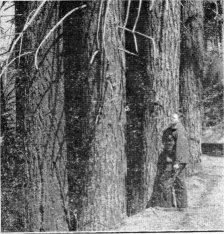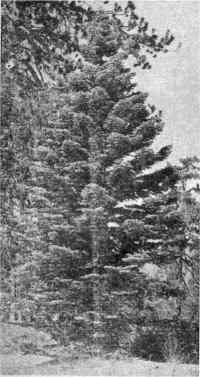
[click to enlarge]
| Online Library: | Title | Author | California | Geology | History | Indians | Muir | Mountaineering | Nature | Management |
Yosemite > Library > Cone-bearing Trees > White Fir >
Next: Red Fir • Contents • Previous: Single-leaf Pine
Abies concolor (Gard.) Parry.

[click to enlarge] |
White Fir reaches its greatest development in the fertile areas of this belt, especially in canyon bottoms. It is not only among the tallest trees of the Sierra forest but grows to greater height and girth here than in any other place in the world. Trees 140 to 180 feet high and from three and one-half to five feet in diameter are common in Yosemite whereas in the Rocky Mountains where this species also occurs they are but half this size. Occasionally a White Fir found here towers over 200 feet with a thickness of eight feet. W. L. Jepson mentions a particular tree near the upper end of Merced Lake that is 160 feet high with a trunk eight and one-half feet in diameter at four and one-half feet above the ground. These individual firs of singular size are undoubtedly of great age for trees five feet thick are about 450 years old and a specimen more than half again as large may show a ring count of well over the half thousand mark. Except for a fungus which rots out the heart of most mature firs thus causing premature death, they might attain a much greater age. Bears take advantage of this soft decayed heart-wood in which to build dens. With few exceptions, all the bear dens which have been discovered in trees in Yosemite have been in firs.
Foliage affords the finest clue to tree identification. Six of the seventeen conifers of Yosemite have leaves attached singly to the branchlets: White Fir, Red Fir, Mountain Hemlock, California Nutmeg, Douglas Fir, and Single-leaf Pine; one has leaves attached in bundles of two: the Lodgepole; four have leaves attached in bundles of three: Western Yellow Pine, Jeffrey Pine, Digger Pine, and Knobcone Pine; three have leaves attached in bundles of fives: Sugar Pine, Western White Pine, and White-bark Pine; while three others have scale-like leaves: Giant Sequoia, Incense Cedar and Western Juniper.

[click to enlarge] |
The White Fir and Red Fir which are the true firs are distinguishable from the Douglas Fir, called a fir for lack of a more appropriate name, by the way the needles are attached. On the lower branches of White Firs, they project horizontally to right and left or on higher branches as with the Red Firs they ascend in two ranks along the branches. The leaves of Douglas Firs stand out all around the branches and neither grow upright nor form flattened rather rigid sprays.
In contrast to the two firs the leaves of Mountain Hemlock have distinct but short leaf stalks or petioles which connect the leaves to the branches, but like the Douglas Fir their needles encircle the branches appearing, however, thicker on the upper side. The leaves of the California Nutmeg are arranged similarly to those of the White Fir but are readily distinguished by being sharp pointed, flat, and lance-shaped. If bruised they emit an ill-smelling odor. Other factors, such as size, shape and manner of attachment of cones, color and pattern of bark, and elevation or zone most frequently encountered in addition to the type of foliage, assist in recognizing tree species. Interested readers will find these factors for each Yosemite conifer listed at the close of the pamphlet.
White Fir leaves are short (three-fourths to two inches long) and are dark yellow-green when young, but become paler with a whitish tinge as they become older. Their habit of growth is similar to that described for the Red Firs excepting those of White Firs have a more pronounced tendency of growing in flat sprays. The trunks of young trees and the upper growing parts of older stems are white or silvery like those of the white pines, but rapidly become rough and broken by deep fissures. The ashy gray bark is brownish-yellow within.
Next: Red Fir • Contents • Previous: Single-leaf Pine
| Online Library: | Title | Author | California | Geology | History | Indians | Muir | Mountaineering | Nature | Management |
http://www.yosemite.ca.us/library/cone-bearing_trees/white_fir.html